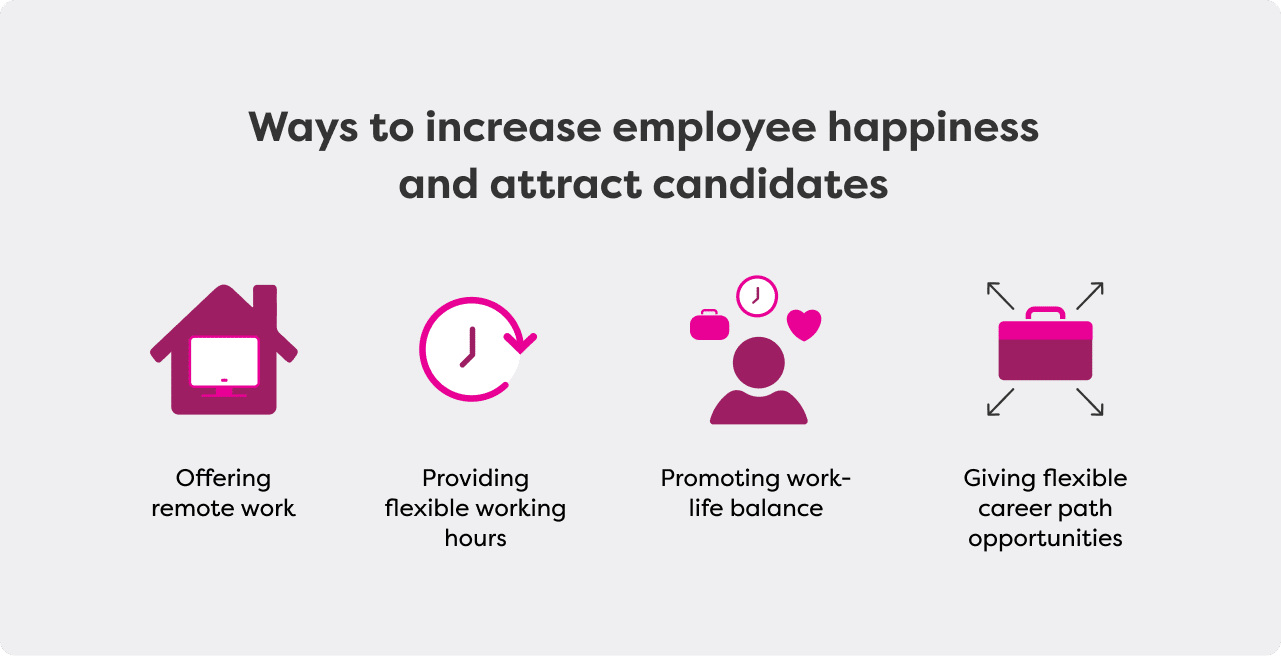The past few years have profoundly redefined the relationship between recruiters and job seekers. After the pandemic and the consequent expansion of remote work, employees’ expectations have changed, much like their vision of work.
This shift has made 32% of workers feel comfortable quitting their jobs without having another one lined up. These numbers show that employers and recruiters need, now more than ever, to meet candidates’ expectations to hire the best talent.
1) Work-Life Balance and Trust
You will probably not be surprised to learn that flexibility remains the top priority for most job seekers in 2025. Accordingly, 5-day-a-week office job opportunities are often turned down by candidates, and they won’t receive many applications.
Professional lives and general lifestyles have undoubtedly changed, and employers must be ready to follow suit by offering trust and workplace flexibility in all its forms, namely:
- Remote and hybrid work;
- Flexible working hours;
- Macromanagement rather than micromanagement;
- Work and personal-life/family-life balance.
Therefore, if your company and the open position can offer these perks, detail the policies in your job postings. You should also be honest about the level of flexibility you can provide from the first exchanges with the candidate. Indeed, transparency will save both the recruiter and applicant a lot of time and effort and build a trusting relationship necessary for flexibility from the get-go.
2) Compensation and Benefits
Of course, salary and benefits remain a top priority for job seekers. Once again, we recommend transparency about hourly wages and additional benefits in your job postings and during exchanges with the candidate.
Monetary compensation is not the only compensation considered by applicants, however. They are also looking for key benefits that companies often overlook, namely mental health support policies, good health insurance, transportation coverage (if they work in the office), and much more. Indeed, after the pandemic, workers have learned to prioritize their mental and global health and want to be supported accordingly in the workplace.
If you want to rebuild your compensation and benefits program to meet job seekers and future employees’ expectations, why not ask your staff what they think? Chances are they have the same wishes and would love to help you improve your benefits package by sharing their feedback. Employee surveys are the best way to collect employee feedback efficiently and confidentially.
3) Culture Fit and Company Values
Recent HR statistics show that younger generations of workers want to be a culture fit for their new company. Accordingly, 64% of millennials would rather work at a lesser-paid job they love than at a job they find boring. While this shows that workers now wish to take on more stimulating tasks and projects, they also want to experience a comfortable and healthy work environment.
That’s where your company culture comes into play: be sure to share your company values from the start and introduce what life is truly like in your organization. For example, potential employees want to know that inclusion, empathy, kindness and trust are core values in your company. They are also gauging if they can build meaningful relationships in the workplace through their manager-employee relationship, company events, and team-building activities.
Let them know what you have to offer, and remember that actions speak louder than words: company values should not be a front to hire and onboard new employees but a genuine commitment on your part. Your staff spends most of their week at work, so make sure that they can thrive in a healthy professional environment.
4) Career Growth Opportunities
We mentioned that employee retention and engagement increasingly depend on a passion for the job, but how can we ensure that initial infatuation turns into long-term loyalty?
You guessed it: career growth and professional development programs are crucial to maintaining good levels of employee engagement in the long run. This is no surprise, considering that candidates are looking for these training and development opportunities when applying for a new position.
Nowadays, workers want to grow and discover new professional perspectives in their company, and ongoing training efforts will make your employer brand stand out. Although formal training should be an essential part of your strategy, other aspects should also be considered:
Comprehensive Career and Performance Management
Frequent meetings with employees will help you assess their performance and progress and determine if they are ready to take the next step in their professional journey. Setting stimulating goals during effective performance reviews will also keep employee motivation levels high.
Performance Review and Career Tracking Tools
Evaluating performance is child’s play when you use the right tools. In addition, it is much easier to track individual career progress with a centralized HR platform allowing you to retrieve information quickly. Did you know that Folks HR offers a performance management software and comprehensive career tracking tools to optimize your overall workforce management?
Effective Recognition Programs
44% of employees switch jobs because they don’t receive recognition from their managers and peers. A culture of recognition will foster employee happiness and guide your professional development initiatives by identifying what makes the worker a good performer and which skills could be improved in the future.
Ongoing Training and Learning Efforts
While formal training sessions are great and should be implemented, your employee should discover new aspects of their role on a regular basis. This ongoing learning process can be as simple as sharing a video or ebook on a relevant topic and leaving the employee time to consume it. As a manager, you can provide extensive support and share tips and tricks to help your employee learn and grow.
5) A Positive Candidate Experience
We have previously mentioned the importance of transparency and open communication throughout the hiring process. Just like you, job seekers don’t want to lose their time applying and interviewing for positions that might not meet their expectations and contexts.
You should communicate thoroughly through phone calls and emails, even during onboarding.
However, creating a seamless, positive candidate experience can be complex and time-consuming for recruiters and HR managers alike. Fortunately, appropriate recruitment solutions can help you save time and focus on what matters most: your candidate or hire journey. Applicant Tracking Systems (ATS) will streamline your recruiting process and automate emailing, resume filing, and much more! As such, they are the best recruiting tool to optimize candidate experience and make the best first impression.

If you want to meet job seekers’ expectations in 2025, you should be upfront about your own needs and requirements. Hiring is difficult enough as it is in the current context. You don’t want to rush the process just to fill a position and later find out that the new hire is not fit for the role or doesn’t want to stay in your company in the long run. Open communication will be vital to finding the best player for your organization and ensuring that they will be happy to work with you. In short, a positive hiring experience is the first step in your employee engagement strategies.
Of course, hiring processes that consider job expectations take time and energy. However, with an efficient ATS (Applicant Tracking System), you will save time on administrative tasks and be able to focus on meaningful communication with your candidates!
Discover how ATS can improve your recruitment process and hire experience:
Folks ATS is an affordable recruiting solution for SMBs!

